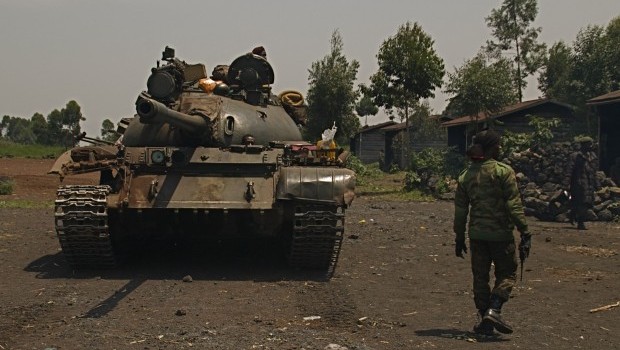
A Congolese government tank prepares to deploy for fighting against M23 rebels, at an operating base in Kanyaruchinya, north of Goma, eastern Congo, Friday, Aug. 23, 2013. (AP Photo/Joseph Kay)
Kinshasha, AP—United Nations helicopters fired on rebels fighting Congolese troops just outside a city of nearly 1 million people in eastern Congo on Wednesday, ratcheting up the UN’s role in Congo’s current conflict, officials said.
The fighting began just before 8 a.m. Wednesday in the hills of the Kibati area, about 9 miles (15 kilometers) north of the provincial capital of Goma, according to both a government and a UN spokesman. The rebels confirmed that they had been attacked by ground troops as well as from the air.
“There was a big offensive this morning. The government’s army, helped by the United Nations attacked our positions near Goma with aircrafts, with combat tanks and with infantry,” said the president of the M23 rebel movement, Bertrand Bisimwa, who spoke by telephone.
He said the UN’s intervention brigade was on the frontline of the fighting: “It was the UN that was shooting directly at us, from their helicopters. It’s the Tanzanian and South African (United Nations) troops that are on the frontline. It’s them that we see first,” he said.
The UN’s intervention brigade was created as a result of intense international pressure after the rebels briefly held Goma late last year, and UN peacekeeping forces stood by because they were only authorized to protect civilians. The UN Security Council approved the creation of the intervention brigade in March, giving the troops an expanded mandate allowing them to fight the M23 rebels.
In the weeks since the brigade has been deployed in eastern Congo, officials have given mixed messages about its role in the conflict, always stressing that the brigade was fighting “alongside” or “behind” Congolese army troops.
On Wednesday, officials reiterated that they were playing a support role. “The main engagement is by the (Congolese) forces,” said Siphiwe Dlamini, a spokesman for the South African military, which contributed South African troops to the brigade. “We are retaliating and going on the offensive.”
Lt. Col. Felix Basse, the military spokesman for the UN peacekeeping mission, known as MONUSCO, also said that UN forces were taking part in the fighting alongside the Congolese army Wednesday.
“MONUSCO has enlisted all of its attack helicopters and its artillery … to push back the M23 offensive that is under way right now on the hills of Kibati,” he told journalists in the capital of Kinshasa.
The UN mission has been utilizing its attack helicopters since Aug. 22 in an effort to back the ground forces.
The M23 fighters launched their rebellion last year and peace talks with the Congolese government have repeatedly stalled.
Martin Kobler, the head of the UN peacekeeping mission, said the UN forces were doing their best to protect the city of Goma from rebel attacks.
“We can’t guarantee the security of Goma’s population but we can do all we can to improve security and prevent shells and other threats,” he said.
The intervention brigade—consisting of Tanzanian, South African and Malawian soldiers—reinforces the 17,000 UN blue helmeted peacekeepers already in Congo. The peacekeepers can only protect civilians. The new intervention brigade, however, has a stronger mandate and is authorized to battle the rebel forces operating in mineral-rich eastern Congo.
The UN intervention brigade now in place promises to give the Congolese troops greater backing in their efforts to eliminate the rebel threat, though the new intervention brigade also stands to make UN forces more vulnerable to attack when they are seen as being on the offensive rather than a neutral force simply protecting civilians.
